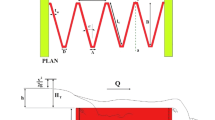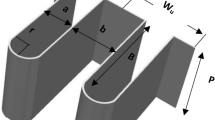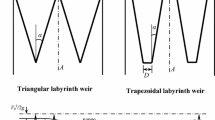Abstract
In recent decades, the advancement of knowledge on the hydraulics of labyrinth weirs has resulted mainly from physical modeling. In this study, numerical simulations of free-flow and submerged labyrinth weirs were conducted for a large sidewall angle, using commercially available computational fluid dynamics software, for three different turbulence models. These simulations were compared with experimental data gathered in a fairly large-scale facility. In general, very good agreement was found on the discharge capacity, in free-flow and submerged conditions, regardless of the turbulence model tested. A dimensionless approaching free surface profile, which was virtually independent of the relative upstream head, was obtained. Downstream of the weir, under subcritical flow conditions, the numerical flow depths agreed reasonably well with the corresponding experimental data.










Similar content being viewed by others
Abbreviations
- a :
-
Half width of the labyrinth weir apex
- C L :
-
Dimensionless discharge coefficient related to the centerline length of the weir crest L
- F s :
-
Safety factor
- g :
-
Gravitational acceleration
- H d :
-
Total downstream head over the weir crestin a submerged condition
- H t :
-
Total upstream head over the weir crestin a free-flow condition
- H * :
-
Total upstream head over the weir crestin a submerged condition
- h :
-
Free surface elevation over the weir crest
- h 0 :
-
Depth of flow over the weir crestin a free-flow condition
- L :
-
Total centerline length of the labyrinth weir crest
- n :
-
Number of labyrinth weir cycles
- P :
-
Labyrinth weir height
- p :
-
Pressure
- Q :
-
Labyrinth weir discharge
- S M :
-
Momentum source
- t :
-
Time
- t w :
-
Vertical thickness of labyrinth weir wall
- U :
-
Velocity vector
- U 0 :
-
Mean velocity upstream of the labyrinth weir
- \( u_{i}^{{\prime }} \) :
-
Turbulent velocity in each direction (i: 1–3 for x, y, z directions, respectively)
- W :
-
Channel width
- w :
-
Cycle width of the labyrinth weir
- x :
-
Horizontal distance
- y 10 :
-
Characteristic depth where the local air concentration is 10%
- y 90 :
-
Characteristic depth where the local air concentration is 90%
- α :
-
Labyrinth weir sidewall angle
- δ :
-
Kronecker delta function
- ε :
-
Dissipation rate of turbulent kinetic energy
- \( k = \left( {1/2} \right)\overline{{u_{i}^{{\prime }} u_{i}^{{\prime }} }} \) :
-
Turbulent kinetic energy
- µ t :
-
Eddy dynamic viscosity
- ρ :
-
Density
- \( -\uprho\overline{{u_{\text{i}}^{{\prime }} u_{\text{j}}^{{\prime }} }} \) :
-
Reynolds stress (i = 1–3 for x, y, z directions, respectively)
- σ :
-
Standard deviation of the relative error of CL
- τ :
-
Stress tensor
References
Azimi AH (2013) Discussion of ‘Experimental studies on flow over labyrinth weir’ by B. V. Khode, A. R. Tembhurkar, P. D. Porey, and R. N. Ingle. J Irrig Drain Eng 139(12):1051–1053
ANSYS Inc. (2016) ANSYS CFX. Solver Theory Guide. Release 18.0
ASCE Task committee on 3D free-surface flow model verification and validation (2009) Verification and validation of 3D free-surface flow models. Environmental and Water Resources Institute (EWRI), Reston, VA
Bilhan O, Cihan Aydin M, Emin Emiroglu M, Miller CJ (2018) Experimental and CFD analysis of circular labyrinth weirs. J Irrig Drain Eng 144(6):04018007
Boileau P (1854) Traité de la mesure des eaux courantes, ou, Expériences, observations et méthodes concernant les lois des vitesses, le jaugeage et l’évaluation de la force mécanique des cours d’eau de toute grandeur, le débit des pertuis usines, des fortifications et des canaux d’irrigation, et l’action dynamique des courants sur les corps en repos. Mallet-Bachelier, Gendre et Successeur de Bachelier, Paris, France
Crookston BM (2010) Labyrinth weirs. Ph.D. Thesis, Utah State University, Logan, UT, USA
Crookston BM, Anderson RM, Tullis BP (2018) Free-flow discharge estimation method for Piano Key weir geometries. J Hydro-environ Res 19:160–167
Crookston BM, Tullis BP (2012) Labyrinth weirs: nappe interference and local submergence. J Irrig Drain Eng 138(8):757–765
Crookston BM, Tullis BP (2013) Hydraulic design and analysis of labyrinth weirs I: discharge Relationships. J Irrig Drain Eng 139(5):363–370
Crookston BM, Tullis BP (2013) Hydraulic design and analysis of labyrinth weirs II: nappe aeration, instability, and vibration. J Irrig Drain Eng 139(5):371–377
Darvas LA (1971) Discussion of ‘Performance and design of labyrinth weirs’, by Hay and Taylor. J Hydraul Eng 97(80):1246–1251
Denys F, Basson G (2018) Transient hydrodynamics of Piano Key weirs. In: 7th IAHR international symposium on hydraulic structures, Aachen, Germany
Falvey HT (2003) Hydraulic design of Labyrinth Weirs. ASCE Press, Reston
Gupta SK, Singh VP (2013) Discussion of ‘Experimental studies on flow over labyrinth weir’ by B. V. Khode, A. R. Tembhurkar, P. D. Porey, and R. N. Ingle. J Irrig Drain Eng 139(12):1051–1053
Hager WH, Pfister M, Tullis BP (2015) Labyrinth weirs: developments until 1985. In: Proceedings of 36th IAHR World Congress, The Hague, The Netherlands
Hay N, Taylor G (1970) Performance and design of labyrinth weirs. J Hydraul Eng 96(11):2337–2357
Houston KL (1983) Hydraulic model study of Hyrum Dam auxiliary labyrinth spillway. Report No. GR 82-13, U.S. Bureau of Reclamations, Denver, Colorado
Khode BV, Tembhurkar AR, Porey PD, Ingle RN (2012) Experimental studies on flow over Labyrinth Weir. J Irrig Drain Eng 138(6):548–552
Launder BE, Sharma BI (1972) Application of the energy dissipation model of turbulence to the calculation of flow near a spinning disc. Lett Heat Mass Transf 1(2):131–138
Lopes R (2011) Capacidade de vazão, energia específica residual e caracterização do escoamento de emulsão ar-água em soleiras descarregadoras em labirinto. Ph.D. thesis, Instituto Superior Técnico, Universidade Técnica de Lisboa, Lisbon, Portugal (in Portuguese)
Lopes R, Matos J, Melo JF (2009) Discharge capacity for free-flow and submerged labyrinth weirs. In: Proceeding 33rd IAHR congress: water engineering for a sustainable environment, Vancouver, Canada
Lopes R, Matos J, Melo JF (2011) Flow properties and residual energy downstream of labyrinth weirs. In: Erpicum S, Laugier F, Boillat J-L, Pirotton M, Reverchon B, Schleiss A (eds) Labyrinth and piano key weirs—PKW 2011. CRC Press, Leiden, pp 97–104
Lux F, Hinchliff DL (1985) Design and construction of labyrinth spillways. In: Proceedings of the 15th congress ICOLD, vol 4, Q59-R15, Lausanne, Switzerland, pp 249–274
Magalhães AP, Lorena M (1989) Hydraulic design of labyrinth weirs. Rep. No. 736, National Laboratory of Civil Engineering, Lisbon, Portugal
Matos J, Frizell, KH (1997) Air concentration measurements in highly turbulent aerated flow. In: Wang SSY, Carstens T (eds) Proceedings of the 27th IAHR congress, San Francisco, USA, vol 1, pp 149–154
Menter FR (1994) Two-equation eddy-viscosity turbulence models for engineering applications. AIAA J 32(8):1598–1605
Roache PJ (1997) Quantification of uncertainty in computational fluid dynamics. Annu Rev Fluid Mech 29:123–159
Salazar F, Mauro JS, Oñate E, Toledo M (2015) CFD analysis of flow pattern in labyrinth weirs. In: Dam Protections against Overtopping and Accidental Leakage—proceedings of the 1st international seminar on dam protections against overtopping and accidental leakage, Madrid, Spain
Savage BM, Crookston BM, Paxson GS (2016) Physical and numerical modeling of large headwater ratios for a 15° labyrinth spillway. J Hydraul Eng 142(11):04016046
Schleiss AJ (2011) From Labyrinth to Piano Key weirs—a historical review. In: Proceedings of the international conference on Labyrinth and Piano Key Weirs, Liege, Belgium
Taylor G (1968) The performance of labyrinth weirs. Ph.D. thesis, University of Nottingham, UK
Torres C, Borman D, Sleigh A, Neeve D (2017) Three dimensional numerical modelling of full-scale hydraulic structures. In: Proceedings of the 37th IAHR world congress, Kuala Lumpur, Malaysia, pp 1335–1343
Torres C, Borman D, Sleigh A, Neeve D (2018) Determination of scale effects for a scaled physical model of a Labyrinth weir using CFD. In: 7th IAHR international symposium on hydraulic structures, Aachen, Germany
Tullis BP (2018) Size-scale effects of labyrinth weir hydraulics. In: 7th IAHR international symposium on hydraulic structures, Aachen, Germany
Tullis JP, Nosratollah A, Waldron D (1995) Design of labyrinth spillways. J Hydraul Eng 121(3):247–255
Tullis B, Young J, Chandler M (2007) Head-discharge relationships for submerged labyrinth weirs. J Hydraul Eng 133(3):248–254
Vatankhah AR (2014) Discussion of ‘Hydraulic design and analysis of labyrinth weirs. I: discharge relationships’ by B. M. Crookston and B. P. Tullis. J Irrig Drain Eng. https://doi.org/10.1061/(asce)ir.1943-4774.0000751
Vatankhah AR, Eslahi N (2013) Discussion of ‘Experimental studies on flow over labyrinth weir’ by B. V. Khode, A. R. Tembhurkar, P. D. Porey, and R. N. Ingle. J Irrig Drain Eng 139(12):1051–1053
Villemonte JR (1947) Submerged-weir discharge studies. Eng News Rec 866:54–57
Willmore CM (2004) Hydraulic characteristics of labyrinth weirs. M.S. Report, Utah State University, Logan, UT, US
Yakhot V, Smith LM (1992) The renormalization group, the ɛ-expansion and derivation of turbulence models. J Sci Comput 7(1):35–61
Acknowledgements
This study was carried out in the framework of a research stay by the first author at the Instituto Superior Técnico, University of Lisbon, funded by the PMPDI-UPCT-2018 Program of the Universidad Politécnica de Cartagena. The support given in the framework of the Ph.D. thesis of the third author by the Fundação para a Ciência e Tecnologia (FCT), Portugal, Project PTDC/ECM/108128/2008, and by the National Laboratory of Civil Engineering (LNEC), in particular by Dr. J. Falcão de Melo, is acknowledged. The authors also thank the support given by the Fundación Séneca, Project 20879/PI/18, to the numerical modeling simulations.
Author information
Authors and Affiliations
Corresponding author
Additional information
Publisher's Note
Springer Nature remains neutral with regard to jurisdictional claims in published maps and institutional affiliations.
Rights and permissions
About this article
Cite this article
Carrillo, J.M., Matos, J. & Lopes, R. Numerical modeling of free and submerged labyrinth weir flow for a large sidewall angle. Environ Fluid Mech 20, 357–374 (2020). https://doi.org/10.1007/s10652-019-09701-0
Received:
Accepted:
Published:
Issue Date:
DOI: https://doi.org/10.1007/s10652-019-09701-0




